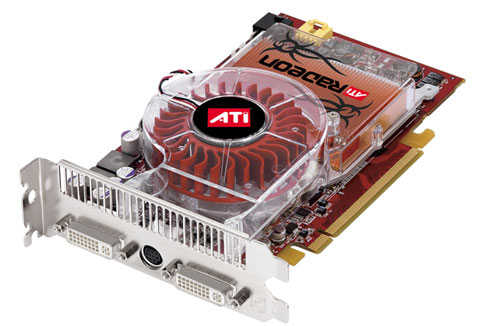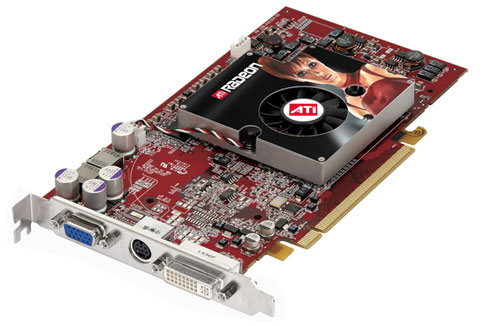ATI's New Radeon X850 and X800 Lines: A Smorgasbord of GPUs
by Anand Lal Shimpi & Derek Wilson on December 1, 2004 9:41 AM EST- Posted in
- GPUs
Some people didn't expect it to happen this season, and it is a little late in the year. But it is still fall, and, still on schedule, ATI's fall refresh part is here. Maintaining the 6 month product cycle has been quite struggle over the past few years, and seems to have stretched into something more like 7 or 8 months. We'll have to wait and see what happens this spring before we can really see if the industry is going to start relaxing the product cycle a little, or if this last round was just a little more intense for both ATI and NVIDIA. Today sees the introduction of a new PCI Express only line up from ATI. Rumor has it that ATI will be finishing up their PCI Express to AGP bridge chip sometime in January, so we may see these and other products make their way across platforms sometime next quarter.
The two new chips that ATI is putting on cards today are the R480 and R430. The R480 is the higher end part in this case. There is absolutely no architectural difference between these new chips and the original R423 on which they are based. That being said, they are both, in fact, different chips than their predecessor. This magical fact is made possible through the wonders of process enhancements.
As a fabrication process matures, it is often possible to find ways to do things better, more efficiently, and with fewer defects in the final silicon. These are the types of process enhancements that go on most of the time at any given fab. Generally, as the process gets better, yield improves, costs go down, and profits go up. In the case of the current generation of graphics cards, it took quite a while to go from launch to high availability. Occasionally, it's also possible to find ways of doing things that enhance the performance of the final product as well. At this point, TSMC has been using their 130nm low-k process to fab ATI's R420 and R423 chips for quite some time now.
Having gotten quite comfortable with the 130nm low-k fab technology, as well as the R423, TSMC and ATI have been able to refine the process for the R480 by enhancing the silicon substrate through component selection and placement to further improve signal integrity leading to higher core clock frequencies. They were also able to shorten trace lengths from the core to memory. Unfortunately, we couldn't get ATI to go into any more detail on exactly what "substrate enhancements" were made, but shorter trace lengths translates to the possibility of higher stable memory clock speeds for ATI cards using the enhanced R480 chip.
The differences between the R423 and the R430 are clearer cut. The R430 is fabbed on the 110nm process rather than the 130nm low-k process. ATI isn't able to push the R430 chips at clock speeds that rival the R480, but this matches well with cooler running, lower clocked 16 and 12 pixel pipe solutions (which is exactly what ATI is offering with R430 based cards).
In addition to the fact that the R480 will be a high performance part, it will also be packed on two slot cards. The stock thermal solution ATI provides is quite different from what we've seen in the past, and quite resembles the leaf-blower type systems we've seen attached to older GeForce FX based products. Aside from the hi-revving but throaty turbo charged 4-cylinder-like whine at boot time, the card calms down and runs quite quietly even under the highest gaming stress. To be completely fair, we haven't tested it in oven-like weather or at a constant high overclock. If the fan has to spin all the way up, you may get the feeling you've got a Civic with an aftermarket exhaust racing around in your box.
Just so you get an idea of what it sounds like, we've provided an mp3 of our X850 XT PE testbed starting up. The sound level of the fan at the end of the MP3 is the loudest it ever got for us during our testing, but once again we were testing in an open air environment and not in a closed (potentially quite warm) case. For a comparison point, here is an mp3 of the same testbed with an X800 XT starting up.

Dual DVI and Dual Slots are the markings of ATI's X850 line
If owning a single slot solution is a deciding factor, the R430 will fulfill that niche. The lower clocked, 110nm solution won't be fitted with the leaf-blower, but a much smaller hsf. ATI has said that it will be possible to passively cool one of these in a BTX system as well. Getting very quiet, very solid performance out of these chips will be a simple matter.

A single slot and no power connector are the telling characteristics of ATI's 0.11-micron X800 line
Product will likely begin shipping early next week, as this is when it will be available for order online. It won't show up on brick and mortar shelves for a few more weeks. Getting product out the door has been a tough thing for ATI and NVIDIA in the past, especially for their highest end parts. As all parties involved have had some practice with this part for a while, we would have been happier if ATI had gotten on the ball and had product on shelves today, if they do ship next week, they won't be in bad shape. We can't say enough about how important it is to make product available as close to a launch as possible. It doesn't matter how well we compare products if it's impossible to get a hold of them. Unfortunately, unless product is available at launch, it makes it very hard for us to guess when we will see anything come along. Our case and point is the X700 XT. It wasn't available at launch, and we may never see it if the cards we look at today make it out the door.
But that's enough about the chips; let's take a look at what we can expect to see in the way of actual products equipped with these new improved GPUs.










69 Comments
View All Comments
WSquared - Wednesday, December 1, 2004 - link
The article says: "Unfortunately, we haven't located any 12-pipe NVIDIA GeForce 6800 PCI Express solutions...There's one in the UK here:
http://www.overclockers.co.uk/acatalog/copy_of_680...
Look for the "OcUK GeForce 6800 GTo 256MB"
It's a strange 12 pipe card clocked at 350/900. I'm sure it could be down-clocked if required for benchmarks.
archcommus87 - Wednesday, December 1, 2004 - link
Yeah, if frickin' nForce 4 boards with PCI-E would finally come out...Man it's taking so long.
Avalon - Wednesday, December 1, 2004 - link
Keep an eye on the x800 XL. That's the interesting card of the bunch. At a $349 suggested MSRP (you know we'll shortly see deals for $300 for the card), this is a great card. It outperforms the x800 and x850 pro, costs less, and runs on a 16 pipeline architecture. If it has room to overclock, some noticeable performance gains should be there. It sounds like an awesome alternative to the 6800GT for those that are $50 short.skunkbuster - Wednesday, December 1, 2004 - link
why can't ati makde -decent- openGL drivers? they ~still~ suck when it comes to open gl games/softwareMadAd - Wednesday, December 1, 2004 - link
Anand, will you or someone at AT sometime soon please either include 1920x1200 in normal reviews, or, could you do a one off set of benchmarks with all the dx9 cards at your disposal, at 1920x1200 please?
LoneWolf15 - Wednesday, December 1, 2004 - link
#6, the Video Processing Unit is for encode AND decode. This is well documented. From NVidia's website:"Adaptable Programmable Video Processor
Video Decoding
A key element of modern-day video processing, MPEG-2 is the basis for such functions as DVD playback. Through advanced technology functions such as motion compensation and inverse discrete cosine transformation (IDCT), the GeForce 6 Series GPUs handle MPEG-2 decoding very efficiently, offloading the CPU of the heavy lifting involved in video playback. The result is smooth, high-quality video and reduced power usage.
Another important factor is that the GeForce 6 Series GPUs are completely programmable and can handle formats such as WMV9 and MPEG-4. The NVIDIA motion compensation engine can provide decompression acceleration for a variety of video formats including WMV9, MPEG-4, H.264, and DiVX. As with motion compensation for MPEG-2, the NVIDIA video engine can perform most of the computation-intensive work, leaving the easiest work to the CPU.
Video Encoding
The GeForce 6 Series GPUs are also capable of hardware video encode acceleration. Traditionally, video encoding is a difficult and time consuming process. The GeForce 6 Series GPUs include a motion estimation engine. Using state-of-the-art technologies, the motion estimation engine delivers higher-quality video at the same or lower bit rate, as well as lower CPU utilization for improved system performance."
Momental - Wednesday, December 1, 2004 - link
Part of me sees this as a brilliant marketing and test strategy for ATi. Yup. The availability of their high-end cards have been all but non-existent and who's to say this wasn't intentional? Maybe they wanted to throw out some product to see how well it sold and in which flavor (AGP or PCI-e)?Now they know and this is why we'll have no problem getting our hands on these "refreshed" cards in the next 6 to 10 weeks, if not sooner.
I'm suggesting that they merely offered cards like the X800XT PE as a "test drive" to see how well it performed and how quickly it left shelves. My hope is that they don't cripple the X800XL card, which looks to be the "sweet spot" here, because they know it performs better and costs less than the X850Pro!!
In a short while, we'll all see how their new naming convention makes perfect sense as they cull out the "older" cards and make the newer refreshed ones their "top shelf" vodkas. ;)
Noli - Wednesday, December 1, 2004 - link
The X800 XL gives you 16 pipes for $350 on a 0.11 micron chip. With such a small fan (must be cool?) and low core/mem, *if* it overclocks well it could be a blinder and out-do 6800GT for value just below the top of the range cards. I'll be keen to see how it does. Big if though for the moment...archcommus87 - Wednesday, December 1, 2004 - link
I couldn't agree more about naming the products! How can they make something so simple so difficult? Maybe someone more in touch with them like Anand themselves could give them a piece of their mind.Here's how it should be done. Each new type of card can be a new hundreds series, i.e. 100s, 200s, 300s, etc. Then the specific products can be within there. For example, low end 110, middle 150, high 190. And then if they marginally increase the clocks of the best card, make it the 195. Simple!
And I couldn't agree more on prices, too. I remember when the top of the line was $300 (never remember it being less than that). Now if you want the best you're talking almost $600. And for the best CPU? Over $1,000. Absurd. I'd never more than:
$200 for a CPU
$150 for a motherboard
$300, MAYBE $350 for a video card
$150-$200 for memory
$150 for hard drive
bigpow - Wednesday, December 1, 2004 - link
I'd like to see the 6800 in the comparison